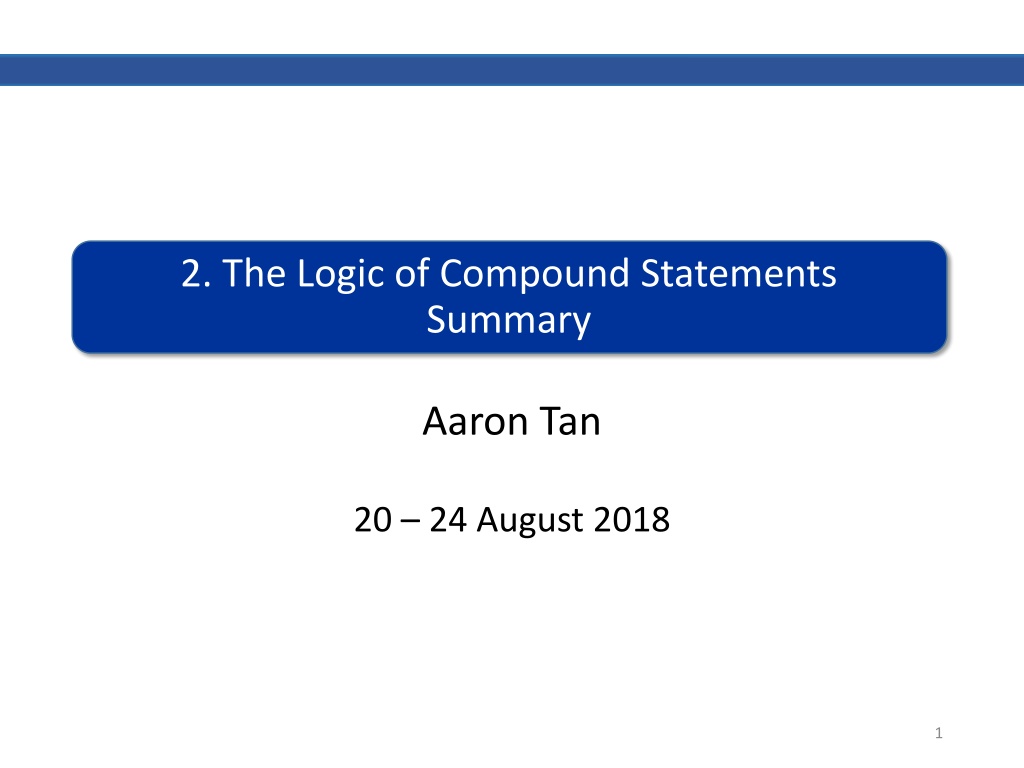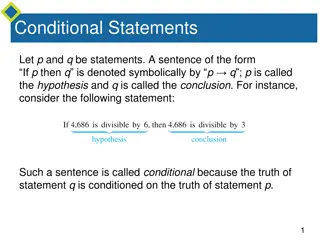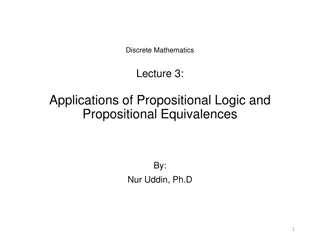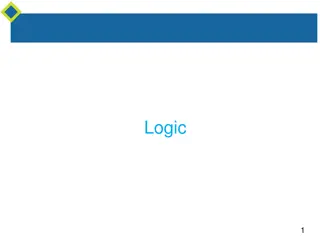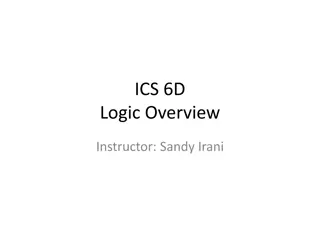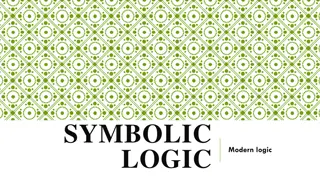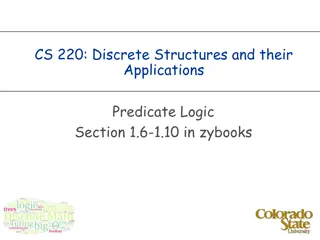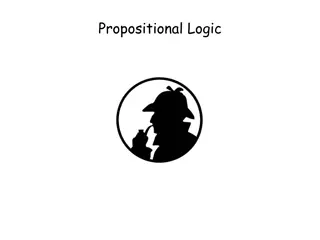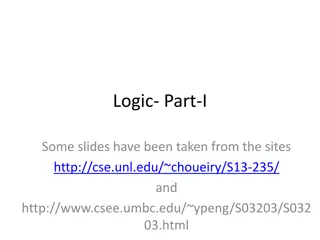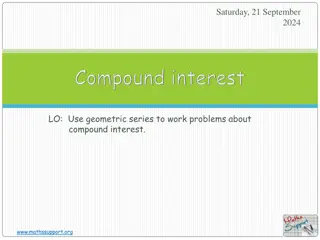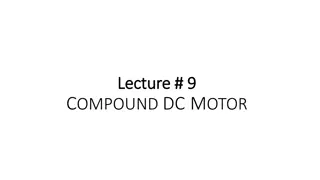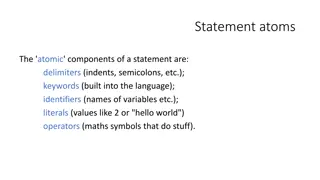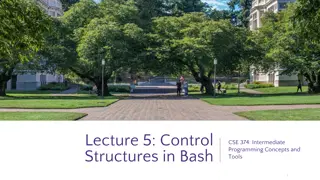Understanding Compound Statements in Logic
The summary discusses the logic of compound statements, covering logical form, equivalence, tautologies, contradictions, conditional statements, valid and invalid arguments, and more. It explains the definitions of statements, negation, conjunction, disjunction, statement form, logical equivalence, tautology, contradiction, and provides theorems on logical equivalences. Additionally, it touches on necessary and sufficient conditions, rules of inference, fallacies, and various laws governing logical expressions.
Download Presentation

Please find below an Image/Link to download the presentation.
The content on the website is provided AS IS for your information and personal use only. It may not be sold, licensed, or shared on other websites without obtaining consent from the author. Download presentation by click this link. If you encounter any issues during the download, it is possible that the publisher has removed the file from their server.
E N D
Presentation Transcript
2. The Logic of Compound Statements Summary Aaron Tan 20 24 August 2018 1
Summary 2. The Logic of Compound Statements 2.1 Logical Form and Logical Equivalence Statements; Compound Statements; Statement Form (Propositional Form) Logical Equivalence; Tautologies and Contradictions 2.2 Conditional Statements Conditional Statements; If-Then as Or Negation, Contrapositive, Converse and Inverse Only If and the Biconditional; Necessary and Sufficient Conditions 2.3 Valid and Invalid Arguments Argument; Valid and Invalid Arguments Modus Ponens and Modus Tollens Rules of Inference Fallacies 2
Summary 2.1 Logical Form and Logical Equivalence Definition 2.1.1 (Statement) A statement (or proposition) is a sentence that is true or false, but not both. Definition 2.1.2 (Negation) If p is a statement variable, the negation of pis not p or it is not the case that p and is denoted ~p. Definition 2.1.3 (Conjunction) If p and q are statement variables, the conjunction of p and qis p and q , denoted p q. Definition 2.1.4 (Disjunction) If p and q are statement variables, the disjunction of p and qis p or q , denoted p q. 3
Summary 2.1 Logical Form and Logical Equivalence Definition 2.1.5 (Statement Form/Propositional Form) A statement form (or propositional form) is an expression made up of statement variables and logical connectives that becomes a statement when actual statements are substituted for the component statement variables. Definition 2.1.6 (Logical Equivalence) Two statement forms are called logically equivalent if, and only if, they have identical truth values for each possible substitution of statements for their statement variables. The logical equivalence of statement forms P and Q is denoted by P Q. Definition 2.1.7 (Tautology) A tautology is a statement form that is always true regardless of the truth values of the individual statements substituted for its statement variables. A statement whose form is a tautology is a tautological statement. Definition 2.1.8 (Contradiction) A contradiction is a statement form that is always false regardless of the truth values of the individual statements substituted for its statement variables. A statement whose form is a contradiction is a contradictory statement. 4
Summary 2.1 Logical Form and Logical Equivalence Theorem 2.1.1 Logical Equivalences Given any statement variables p, q and r, a tautology true and a contradiction false: p q q p (p q) r p (q r) p (q r) (p q) (p r) p true p p ~p true ~(~p) p p p p p true true ~(p q) ~p ~q p (p q) p p q q p (p q) r p (q r) p (q r) (p q) (p r) p false p p ~p false 1 Commutative laws 2 Associative laws 3 Distributive laws 4 Identity laws 5 Negation laws 6 Double negative law p p p p false false ~(p q) ~p ~q p (p q) p 7 Idempotent laws 8 Universal bound laws 9 De Morgan s laws 10 Absorption laws Negation of true and false ~true false ~false true 11 5
Summary 2.2 Conditional Statements Definition 2.2.1 (Conditional) If p and q are statement variables, the conditional of q by pis if p then q or p implies q , denoted p q. It is false when p is true and q is false; otherwise it is true. We called p the hypothesis (or antecedent) and q the conclusion (or consequent). Definition 2.2.2 (Contrapositive) The contrapositiveof a conditional statement if p then q is if ~q then ~p . Symbolically, the contrapositive of p q is ~q ~p. Definition 2.2.3 (Converse) The converseof a conditional statement if p then q is if q then p . Symbolically, the converse of p q is q p. Definition 2.2.4 (Inverse) The inverseof a conditional statement if p then q is if ~p then ~q . Symbolically, the inverse of p q is ~p ~q. 6
Summary 2.2 Conditional Statements p q ~p q Implication law p q ~q ~p contrapositive conditional statement q p ~p ~q inverse converse Note that: p q q p 7
Summary 2.2 Conditional Statements Definition 2.2.5 (Only If) If p and q are statements, p only if q means Or, equivalently, if not q then not p if p then q Definition 2.2.6 (Biconditional) Given statement variables p and q, the biconditional of p and qis p if, and only if, q and is denoted p q. It is true if both p and q have the same truth values and is false if p and q have opposite truth values. The words if and only if are sometimes abbreviated iff. Definition 2.2.7 (Necessary and Sufficient Conditions) If r and s are statements, r is a sufficient condition for s means if r then s r is a necessary condition for s means if not r then not s (or if s then r ) 8
Summary Order of Operations Order of operations: and or ~ not if and only if if-then/implies Coequal in order Coequal in order Performed first Performed last 9
Summary 2.3 Valid and Invalid Arguments Definition 2.3.1 (Argument) An argument (argument form) is a sequence of statements (statement forms). All statements in an argument (argument form), except for the final one, are called premises (or assumptions or hypothesis). The final statement (statement form) is called the conclusion. The symbol , which is read therefore , is normally placed just before the conclusion. To say that an argument form is valid means that no matter what particular statements are substituted for the statement variables in its premises, if the resulting premises are all true, then the conclusion is also true. Definition 2.3.2 (Sound and Unsound Arguments) An argument is called sound if, and only if, it is valid and all its premises are true. An argument that is not sound is called unsound. 10
Summary 2.3 Valid and Invalid Arguments Table 2.3.1 Rules of Inference Rule of inference Rule of inference p q p p q ~q p q ~p q Modus Ponens Elimination p q p q q r p r p q p r q r r ~p false p p q ~q Modus Tollens ~p Transitivity p q Generalization Proof by Division Into Cases p q p q p p q p q q Specialization Contradiction Rule Conjunction p q p q 11
END OF FILE 12
